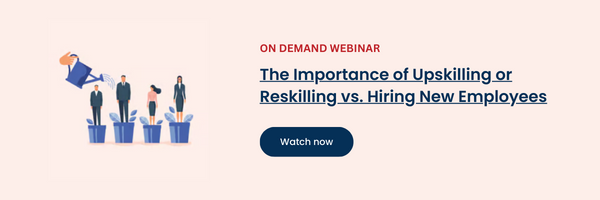In today’s challenging business landscape, organisations are grappling with record-low unemployment, talent shortages, and skill gaps. In response, HR leaders are seeking innovative strategies to attract and retain suitable candidates. One such solution lies in the investment of upskilling and reskilling existing employees. Today, we will explore the value of these strategies, discuss their differences, and outline best practices for implementing successful upskilling and reskilling programs.
By investing in learning and development (L&D), organisations can optimise their resources and retain talented individuals. Research shows that employees who receive promotions have spent significantly more time in training, highlighting the value of upskilling. These programs not only save costs associated with recruitment and onboarding but also lead to increased employee engagement, motivation, and higher retention rates.
Understanding Upskilling and Reskilling
Upskilling involves expanding an employee’s existing skill set, enabling them to enhance their performance in their current role and progress along their career path.
Reskilling, on the other hand, entails learning new skills outside the scope of the employee’s current skill set, potentially leading to lateral career movement or adaptation to organisational changes.
While both strategies contribute to talent development, they differ in the nature of the skills acquired and the end goal of the learning process.
Strategies for Successful Upskilling and Reskilling
To implement effective upskilling and reskilling programs, organisations can follow these strategies:
- Assess the skills gap: Evaluate the current skills of employees and identify the areas that need development to meet organisational needs. This assessment can be conducted through surveys, performance reviews, or skills assessments.
- Develop a training plan: Create a comprehensive training plan based on the skills gap analysis. The plan should outline the skills to be developed, training methods to be used, and the timeline for training. Consider areas such as leadership development, technical skills, and company compliance requirements.
- Select appropriate learning methods: Choose learning methods that suit employees’ needs, skills, competencies, and learning styles. This can include on-the-job training, classroom training, mentoring, coaching, job shadowing, or other suitable methods.
- Provide feedback and support: Offer regular feedback and support to employees throughout the learning process. This helps them improve their skills, stay motivated, and apply their newly acquired knowledge effectively.
- Evaluate effectiveness: After completing the learning and development activities, evaluate their effectiveness by assessing whether employees have acquired the new skills, behaviours, and competencies. Determine how they have applied these skills in their work and how they will be used in their new roles.
- Encourage ongoing learning: Foster a culture of continuous learning by providing opportunities for employees to attend conferences, workshops, and other training programs. Managers and leaders should actively encourage participation in L&D activities and make it a visible part of performance expectations.
Best Practice Examples
To inspire you, here are some best practice examples of successful upskilling and reskilling initiatives:
Graduate recruitment and development programs: Companies like Mackay Regional Council and Microsoft have implemented programs that focus on bringing in new talent and developing their skills.
Online learning programs: Organizations such as IBM, Accenture, PwC, and Google offer online courses and certifications to help employees develop skills in various areas, including cybersecurity, data science, AI, and digital marketing.
Leadership development programs: Mars Corporation, National Australia Bank, and prominent accounting and law firms have leadership academies and graduate programs aimed at nurturing future leaders.
Innovative projects and hackathons: Companies like Simploc Groups promote innovation and skill development through internal projects and hackathons.
Employee development and retention strategies: UM (media agency) and Amazon invest in their employees’ training and development, provide career advancement opportunities, and offer programs like Amazon’s Career Choice, which funds education and certifications.
Measuring the Effectiveness of Upskilling and Reskilling Programs
To determine the impact of upskilling and reskilling initiatives, organisations should consider various factors, including:
- Setting measurable goals aligned with organisational objectives
- Assessing employee productivity and engagement
- Tracking turnover rates
- Evaluating employee success, satisfaction, and career progression
- Monitoring the impact on employer brand presence
- Gathering feedback through the recruitment process.
By adopting a holistic approach to learning and development, organisations can identify future leaders, leverage employees’ transferable skills, provide personalised development solutions, and foster positive and productive organisational cultures.
Upskilling and reskilling offer valuable strategies for organisations seeking to address talent shortages and skill gaps. By investing in the development of existing employees, companies can achieve cost savings, increase employee retention, and create a skilled and motivated workforce capable of meeting evolving business demands. To successfully implement upskilling and reskilling programs, organisations should assess skills gaps, develop training plans, choose appropriate learning methods, provide feedback and support, and foster a culture of continuous learning. By adopting these best practices, organisations can unlock the full potential of their workforce and secure a competitive advantage in today’s rapidly changing business landscape.
If you’d like some help with identifying learning and development needs or implementing effective HR strategies, check out our HR Consulting Services, or book in for a free 15 minute consultation.

Kelly is a motivated HR professional with a passion for strategy and innovation. Kelly has extensive HR management experience in leadership positions, as well as experience in an operational leadership role in the financial services industry which strengthened her commercial acumen and operational excellence, enabling her to align organisational human resource needs to commercial objectives. Kelly has experience across various industries including hospitality, finance and aged care, and excels in developing strategies to align to business outcomes, creating efficiencies and innovation, leading teams, coaching and influencing and stakeholder management.





